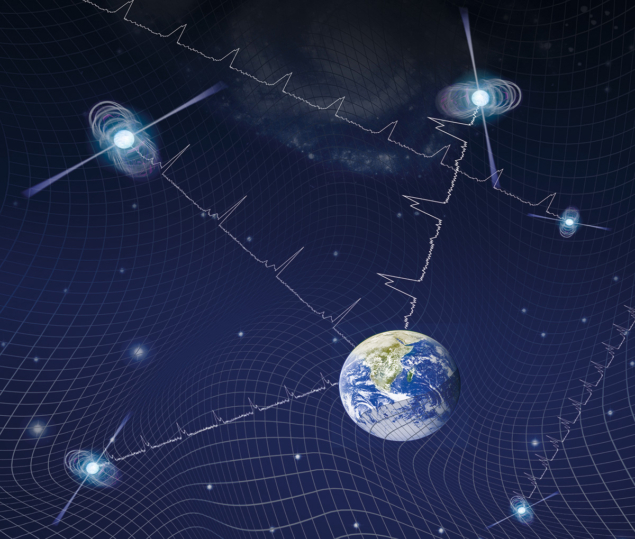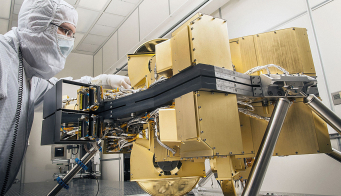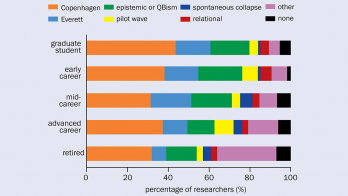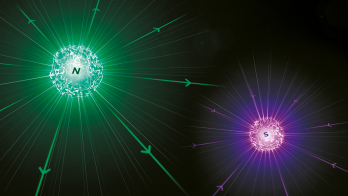Newly appointed EuCAPT director Silvia Pascoli sets out her vision for disentangling fundamental questions involving dark matter, the baryon asymmetry, neutrinos, cosmic rays, gravitational waves, dark energy and other cosmic relics.

Astroparticle physics connects the extremely small with the extremely large. At the interface of particle physics, cosmology and astronomy, the field ties particles and interactions to the hot Big Bang cosmological model. This synergy allows us to go far beyond the limitations of terrestrial probes in our quest to understand nature at its most fundamental level. A typical example is neutrino masses, where cosmological observations from large-scale structure formation far exceed current bounds from terrestrial experiments. Astroparticle theory (APT) has accelerated quickly in the past 10 years. And this looks certain to continue in the next 10.
Today, neutrino masses, dark matter and the baryon asymmetry of the universe are the only evidence we have of physics beyond the Standard Model (BSM) of particle physics. Astroparticle theorists study how to extend the theory towards a new Standard Model – and the cosmological consequences of doing so.
New insights
For a long time, work on dark matter focused on TeV-scale models parallel to searches at the LHC and in ultra-low-noise detectors. The scope has now broadened to a much larger range of masses and models, from ultralight dark matter and axions to sub-GeV dark matter and WIMPs. Theoretical developments have gone hand-in-hand with new experimental opportunities. In the next 10 years, much larger detectors are planned for WIMP searches aiming towards the neutrino floor. Pioneering experimental efforts, even borrowing techniques from atomic and condensed-matter physics, test dark matter with much lower masses, providing new insights into what dark matter may be made of.
I strongly welcome efforts to broaden the reach in mass scales to efficiently hunt for any hint of what the new physics BSM may be
Neutrinos provide a complementary window on BSM physics. It is just over 25 years since the discovery of neutrino oscillation provided evidence that neutrinos have mass – a fact that cannot be accounted for in the SM (CERN Courier May/June 2024 p29). But the origin of neutrino masses remains a mystery. In the coming decade, neutrinoless double-beta decay experiments and new large experiments, such as JUNO, DUNE (see “A gold mine for neutrino physics“) and Hyper-Kamiokande, will provide a much clearer picture, determining the mass ordering and potentially discovering the neutrino’s nature and whether it violates CP symmetry. These results may, via leptogenesis, be related to the origin of the matter–antimatter asymmetry of the universe.
Recently, there has been renewed interest in models with scales accessible to current particle-physics experiments. These will exploit the powerful beams and capable detectors of the current and future experimental neutrino programme, and collider-based searches for heavy neutral leptons with MeV-to-TeV masses.
Overall, while the multi-TeV scale should continue to be a key focus for both particle and astroparticle physics experiments, I strongly welcome the theoretical and experimental efforts to broaden the reach in mass scales to efficiently hunt for any hint of what the new physics BSM may be.

Astroparticle physics also studies the particles that arrive on Earth from all around our universe. They come from extreme astrophysical environments, such as supernovae and active galactic nuclei, where they may be generated and accelerated to the highest energies. Thanks to their detection we can study the processes that fuel these astrophysical objects and gain an insight into their evolution (see “In defiance of cosmic-ray power laws“).
The discovery of gravitational waves (GWs) just a few years ago has shed new light on this field. Together with gamma rays, cosmic rays and the high-energy neutrinos detected at IceCube, the field of multi-messenger astronomy is in full bloom. In the coming years it will get a boost from the results of new, large experiments such as KM3Net, the Einstein Telescope, LISA and the Cherenkov Telescope Array – as well as many new theoretical developments, such as advanced particle-theory techniques for GW predictions.
In the field of GWs, last year’s results from pulsar timing arrays indicate the presence of a stochastic background of GWs. What is its origin? Is it of astrophysical nature or does it come from some dramatic event in the early universe, such as a strong first-order phase transition? In this latter case, we would be getting a glimpse of the universe when it was just born, opening up a new perspective on fundamental particles and interactions. Could it be that we have seen a new GeV-scale dark sector at work? It is too early to tell. But this is very exciting.







